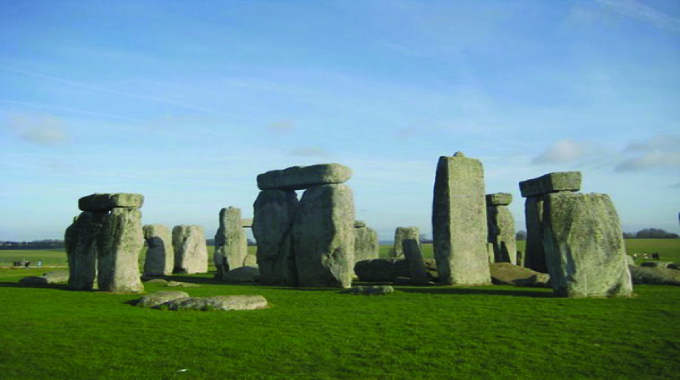Did modern man develop science and technology: I am not convinced

Pathisa Nyathi OVER the years, I have been reading about megalithic structures. These are monumental stone structures some of which served as temples located on energy hubs, where ley lines intersect.
Some were created and built as stone calendars such as David’s Calendar that is the closest to us-near Nelspruit in South Africa.
Such calendars tracked movements of celestial bodies, in particular the sun. Others planets with longer cycles had their movements tracked as these movements affected events on earth.
After several months writing about Stonehenge, I gleaned some knowledge about stone structures in the ancient world.
I sought to gather knowledge from ancients such as those who created, built and used Stonehenge. Other peoples of interest who also built-in stone were the Mayan people, the Aztec and the Incas in Central America and South America. Also of interest were the Egyptians on the African continent.

Stonehenge (Photo Credit: Ancient World Review
It became clear to me that there was some thread that ran through these ancient civilisations. Something intrigues modern man who thinks he is the most civilised with the most advanced science and technology.
The technology of the ancients was certainly informed by their science. We pose many questions regarding their ability to transport and lift stones weighing more than 50 tons.
A good example are the bluestones at Stonehenge in England that are now known to have been quarried in western Wales. Equally puzzling, were the huge sarsen stones brought down all the way from Marlborough and transported to Stonehenge.
Huge blocks of the same sarsen stones were lifted very high to serve as lintels for adjoining sarsen uprights.
These intriguing aspects of ancient civilisations relate to their architecture, transportation and their vast knowledge of astronomy, alchemy, mathematics, and physics. The way they carved stones and made sure they fitted seamlessly is equally puzzling.
It does seem modern science has no answer to the puzzles coming from the past. At some time in the future, a Rosetta Stone that will unpack the human past and its origins will be found.
The ancients did appreciate the idea of eternity resident in stones. Whereas stones are natural, they were used to express beliefs or cultural ideas of the ancients.
There is a lot to glean from existing megaliths. The structures bear witness to advances physics, mathematics and the various forms of energy that were made use of including energy from underground flowing water and the sun.
All this is testimony to the fact that there was advanced science that the ancients were equipped with. Besides the intriguing architecture, transport and astronomy, the ancients preserved their knowledge through paintings in secure caves where the elements would not erase the petroglyphs.
Some of us puzzle at how the art of painting was executed on rock. We come up with all sorts of beautiful guesses. We wish we could know the materials they used. We hunger to decipher the messages that their art forms communicate to us.
These and more questions are packing my mind more so when I seem to realise the ancient knowledge is still in practice in Africa.
My research into what some people prefer to call witchcraft is in the public domain. My intention is not to become wizard. In fact, I cannot become one because of my not having the appropriate spiritual endowment. I am not regretting having embarked on the subject that some despise, fear and hate.
The one thing that I am grateful I did was some rudimentary science. As I delve more and more into ancient African science, into which witches and traditional doctors tap, I come across a lot of science, in particular physics regarding the pervasive energy that is harnessed in the old African professions.
Many of you have heard of or read about how witches fly in a winnowing basket. I am curious to know what energy and related knowledge are harnessed to carry a whole team of big fully-grown witches/wizards.
Only last week someone was telling me about a “train” which was used in the northern part of Zimbabwe to transport passengers through rugged mountainous terrain where there were no footpaths, let alone roads for vehicular transport. When passengers boarded the “train,” they looked down until they got to their destinations. I need more information on this particular “train.”
What takes me to the train is the fact that on some of the dozens upon dozens of petroglyphs I have seen there were drawings of spaceships designed exactly like the NASA spaceships that astronauts use when flying to the moon.
I begin to wonder if current humans are really the first to fly to and from outer space. There must be others ahead of us, probably dating back no less than 400 000 years ago who already were traversing space to get to our earth.
The problem that confounds us is thinking in linear progression. Development is understood in linear terms. This kind of thinking leads us to think we are the most advanced beings as we are at the head of a straight development line.
Behind us we see the Neanderthal man and the Cro-Magnon man who we think did not possess highly developed intellect to have engaged in advanced scientific experimentation and invention.
I do not subscribe to this linear progression of human advancement. My observation with how I have improved my own understanding of culture points to a cyclical progression.
I look back when I first grappled with the concept of amalobolo. On several occasions after that, I have been improving knowledge about amalobolo in a manner that resembles spirals that symbolise a beginning without end.
When I begin to appreciate the advanced science, certainly beyond my comprehension, I begin to acknowledge that science was not developed in modern times.
There have been scientific advancements such as the understanding of genetics and in-vitro fertilisation and cloning.
These are still taking place in the world of applied ancient African science. Surely, you have heard of or read about omantintane, ontikolotshe and imikhoba, the goblins.
The critical question is whether we are able to embrace the idea that indeed there were advanced societies that preceded us? There are self-appointed gatekeepers in this world who will not agree.
They have academic empires to protect. They will not just stand idly by and watch their edifices of academy; knowledge and scholarship come tumbling down.
Ancient civilisations will one day expose our ignorance. There shall come a time when we shall slowly begin to eat humble pie and acknowledge that there were advanced societies that inhabited our planet and left incontrovertible evidence of their settlement on the planet.
The deluge that engulfed Noah and his contemporaries is more than a biblical or fictitious story. Science is proving that indeed there was a flood that obliterated life on our planet.
Science, in the hands of objective men and women is yet to prove that we are not the first to discover science and related technologies. Al that we require is to get rid of our pride and prejudice.











Comments